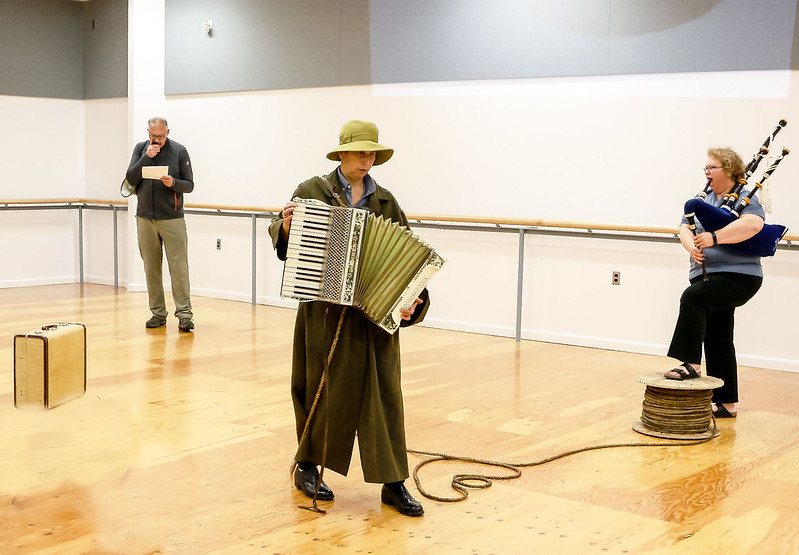Dr. Kathryn Rickett’s Education Dance Students (EDN101) enjoyed a mixed abilities studio with Sunshine Preschoolers. Students had opportunity to tutor preschoolers one-to-one in sessions as well.
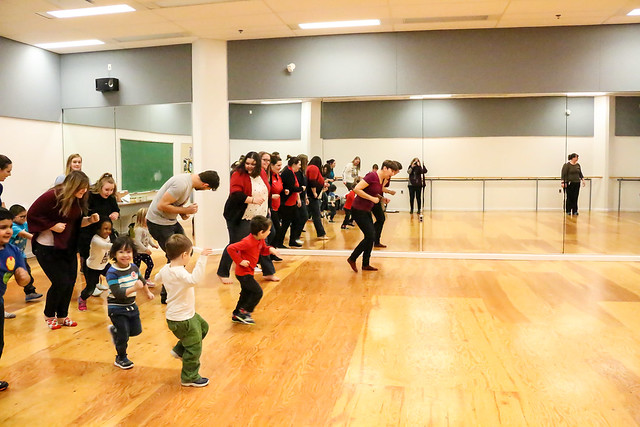
Category: Artwork/Performances/Exhibits
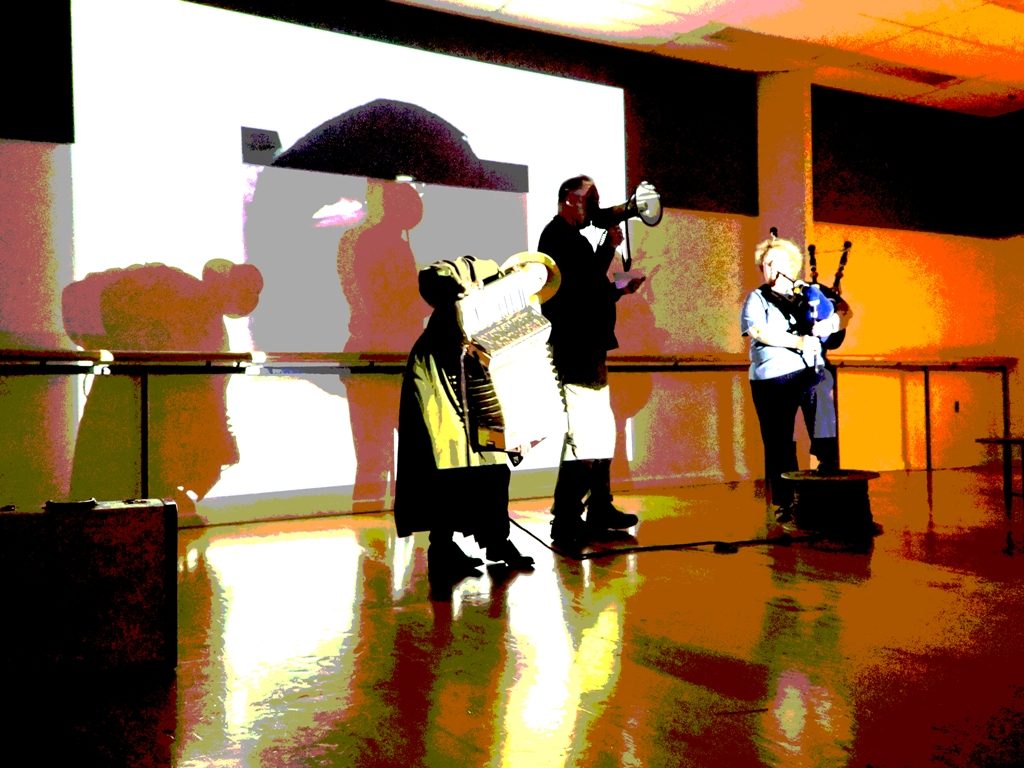
Rehearsing for MAG’s Meet in the Middle Symposium
Dr. Kathryn Ricketts (dance/accordian) and Dr. Gale Russell (bagpipes) with Ian Campbell (media artist) and Ken Wilson (speaker) rehearsing for the “Meet in the Middle | Stations of Migration and Memory Between Art and Film Symposium” that will be held at Mackenzie Art Gallery Nov. 2-5. They will perform Lucky’s Performance Bricolage, an excerpt from Samuel Beckett’s Waiting for Godot, on November 4 at 4:15–4:45 p.m. There will be a workshop after the performance for anyone wanting to participate.
From the Symposium Programme: Kathryn Ricketts will perform a particular rendering of Lucky’s monologue from Samuel Beckett’s Waiting for Godot. This structured improvisation will hinge on fractured text from the play through her unique performative style, folding dance, theatre and voice into a poetic collage of moving images supported by a media artist and bag piper. In the context of the symposium, performer and audience move from Waiting for Godot to notions of liminality and migration and finally to the idea of meeting in the middle from disparate locations.
Video: If These Hills Could Talk – Day of Education for Reconciliation
Early in her artist residency at the University of Regina, Daya Madhur was invited to support the preservice education students on their professional development field trip to Fort Qu’Appelle where the history and beauty of the valley inspired her creative journey.
Daya says,
“As I reflected upon the landscape I often sought to personify the hills and question what they have seen and heard. When creating this performance piece I wanted to portray the complexity of the residential school experience in Lebret and Fort Qu’Appelle. Throughout the creation process I visualized layers as seen from my perspective, historic documents, the students’ lived experiences, and Elder Starblanket’s narrative, soundscape recordings of the river valley, movement, and even the narrative told through the fabric in the dance. My heart lies in the interdisciplinary and I wanted to include all aspects of the fine arts in this project. The initial performance consisted of a dance/drama piece that interacted with the narratives and projected images.”
The video below is a curated adaptation of the performance piece performed on April 14, 2016 at the Walking Together: Day of Education for Truth and Reconciliation hosted by the Faculty of Education, University of Regina and the National Research Centre for Truth and Reconciliation (NCTR).”
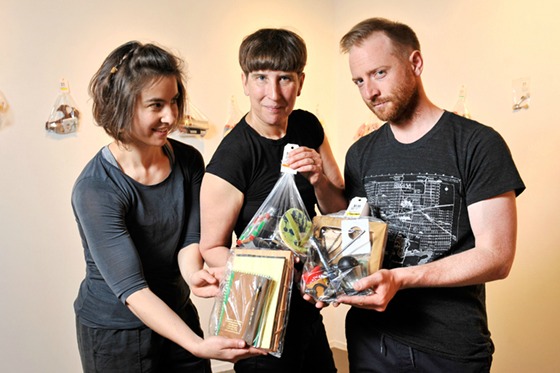
Performance Exhibit Brings Discarded Items to Life ~Q&A
For a long time, Kathryn Ricketts, assistant professor of Arts Education, has enjoyed the wall of Value Village, where clear plastic bags hang and are filled with discarded household items.
The bags usually sell for $2.99. They represent a good deal for some shoppers, but for others, they’re just a collection of useless items.
For Ricketts, it’s inspiration for an exhibition, a series of workshops and performances.
The Anthropology of the Discard is now on display at Fifth Parallel Gallery at the U of R. The public is invited to a performance May 12 at 7:30 p.m. with a closing reception to follow.
We spoke with Kathryn and asked her what she saw at Value Village that inspired her to come up with this idea.

I live close to Value Village and found myself visiting the wall of bags frequently. I was compelled by the combination of objects and how they seemed to have their own logic in connection to each other. It made me think about the person who decided which objects should be together and thought of him/her as both an Anthropologist and Curator.
I hope to ask Value Village to be an artist in residence for a period so I could work alongside that person in order to understand their choices and maybe I can make some bags as well.
Incidentally there is a wall at the exhibition where bags made by the visitors hang. Value Village has donated a box of objects and we invite anyone who visits the exhibition to be part of it by contributing their own custom made bag!
You say these bags are bulging with compelling possible new narratives. What are some of those narratives?
These are stories that are triggered by seeing the objects. They can be from our own personal memories or mere associations. We all have either in possession and or memory so many objects in our lives that are near and dear to us and have so many stories attached. I buy the bags that contain objects that seem to be attached to some of these stories.
The performance is improvisation. You are joined by local performers Johanna Bundon and Jaydon Pfeifer.
What will people see at the show?

We will start by asking the audience to choose three bags from the wall and then Jayden, Johanna and I will choose the one that seems the most potent with ‘stories waiting to be told’. We will then begin to work with one of the objects to familiarize ourselves with a story and then begin to delve into the others. All of our movement and text is entirely improvised however we are very carefully weaving our stories within an emergent history of stories that are being told by each other. As a result, characters, locations, time periods and situations begin to emerge. At times we record some of this information behind us on large banners of paper which serve as a kind of blue print of the emerging story as a whole. I harken it to standing across the street from an apartment building and watching all of the stories unfold in each of the apartments that seem to tell the story of that entire building.
What are you hoping to take away from this for your teaching?
I believe that stories have a very important place in our community and classrooms. It is through stories that we come to understand our curriculum of the world and how our education curriculum embeds itself within this. Stories are so naturally triggered from artifacts of meaning and have had a place in the classroom for a long time, i.e when we think about Show and Tell. When we work from a conglomerate of objects opposed to just one, we begin to understand how our stories interconnect with others and how this reminds us of our connected humanity.
Event: Anthropology of the Discard
Date: May 12
Time: 7:30 p.m.
Location: Fifth Parallel Gallery – Riddell Centre
A closing reception follows the performance.
By Costa Maragos Posted: May 11, 2016 U of R Feature Stories
Anthropology of the Discard: An Interactive Exhibition
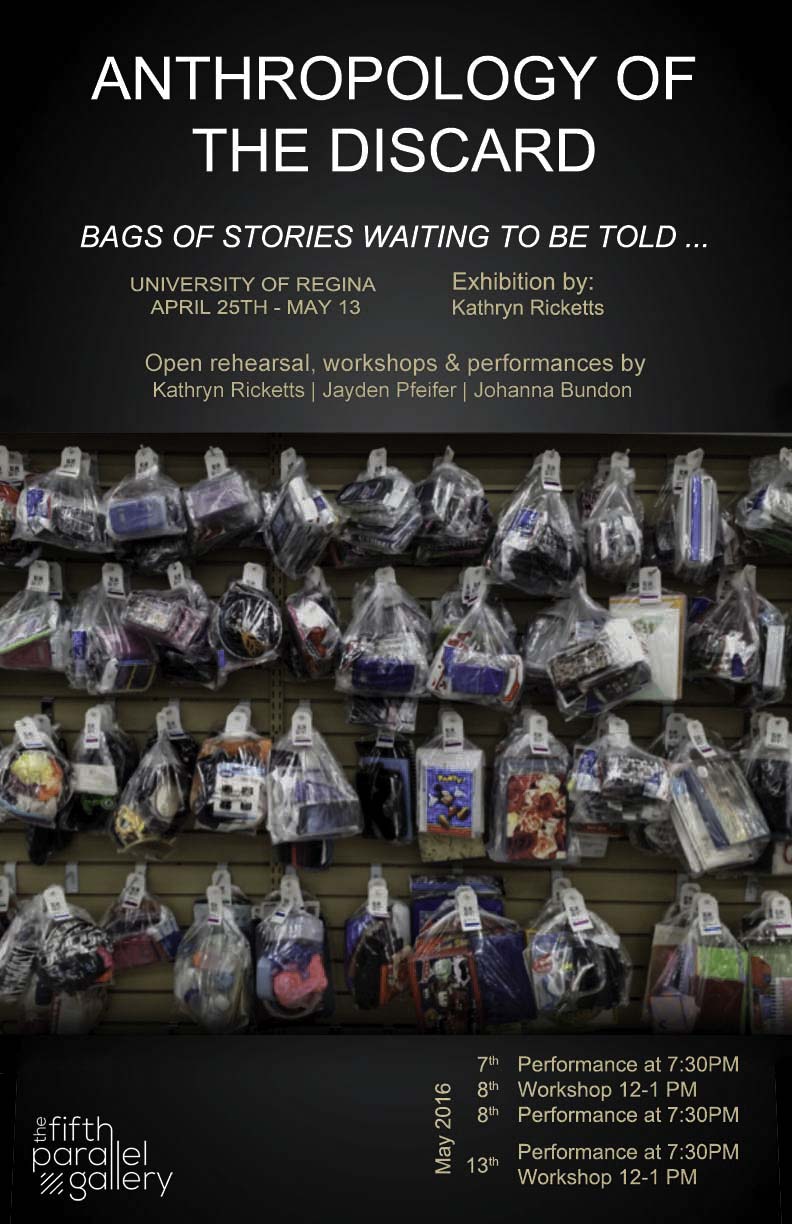 “Anthropology of the Discard” is an interactive exhibition illuminating the saliency of objects as triggers for performative storytelling. It is also a display of artifacts as emblems of lives lived, and lives that refuse to be seen in isolation of each other. Fascinated by the wall of Value Village where conglomerates of objects hang in plastic bags for the standard price of $2.99, Dr. Kathryn Ricketts has collected those that are ‘bulging’ with compelling possible new narratives.
“Anthropology of the Discard” is an interactive exhibition illuminating the saliency of objects as triggers for performative storytelling. It is also a display of artifacts as emblems of lives lived, and lives that refuse to be seen in isolation of each other. Fascinated by the wall of Value Village where conglomerates of objects hang in plastic bags for the standard price of $2.99, Dr. Kathryn Ricketts has collected those that are ‘bulging’ with compelling possible new narratives.
Grad student Jayden Pfeifer and dancer Johanna Bundon have been experimenting along with Kathryn Ricketts for several months around these concepts. Join them in a performative exhibition in April/May at The Fifth Parallel, (U of R, Riddell Centre) where they are excited to share their deepened understanding of the power of objects.
The audience is invited to construct their own bulging bag of stories (ongoing). Bags and objects will be available in the gallery or participants can bring their own constructed bag of objects from home.
Watch an open rehearsal to see how the performed stories are constructed (Posted at Gallery). Watch a 30 min performance of a bulging bag of evocative objects (May 7, 8 & 12th, 7:30 PM). Take in a workshop to learn how to create performative narratives from discarded objects. (May 7 & 8th 12 – 1 PM)

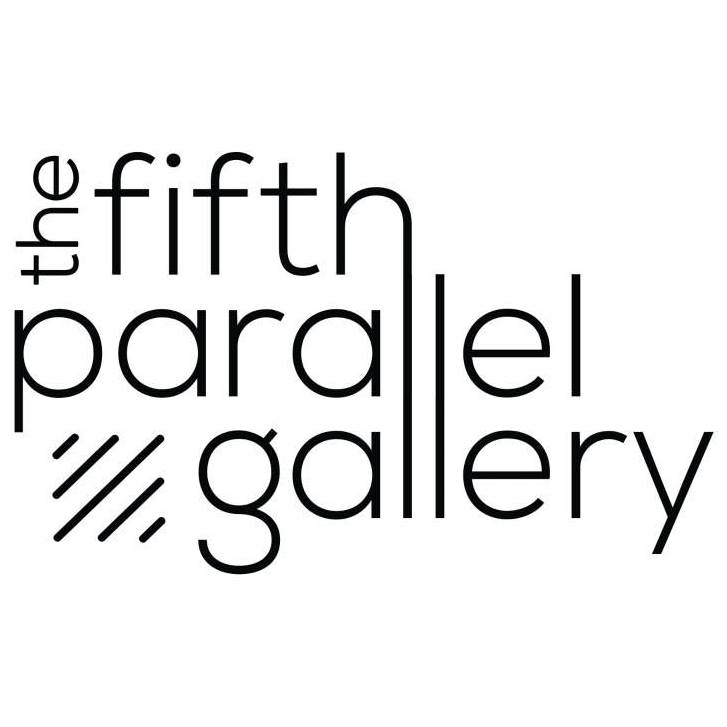


Weaving Stories Between Generations
Posted: February 3, 2016
Dr. Cindy Hanson, Associate Professor in Adult Education at the Faculty of Education, has formed a close relationship with Mapuche women in Southern Chile which has resulted in a book about her work with Mapuche weavers. Dr. Hanson is the author of “Weaving Stories Between Generations.” The book is the result of her research focussing on Mapuche women in southern Chile where Dr. Hanson has spent years getting to know the locals. The idea for a book came from the study participants in Chile.
Below are some random excerpts from Dr. Hanson’s book.
The Relationship with the Mapuche
My work with the Mapuche spans two decades. Way back in the 1990’s, I was teaching Native (Indigenous) Studies in rural Manitoba. I was learning about Indigenous cultures and peoples in Canada and I was also learning about issues that affected their daily lives, for example issues of colonialism that continue to cause harm.
Earlier in my life I had been active in working with Chilean refugees who were coming to Canada to escape the brutalities of Pinochet’s dictatorship.
In the early 1990’s I applied and received a Canadian International Development Agency (CIDA) Professional Award that would take me to Chile for a six-month period to work with Casa de la Mujer Mapuche (House of the Mapuche Women) – a Mapuche women’s organization based in Temuco.
Casa de la Mujer Mapuche worked on areas of health and education, but most significantly it worked with women in 12 Mapuche communities – assisting them with improving and marketing their woven textiles.
Early impressions
 |
| Weavers at Pitrufquén: “The women spoke with pride about weaving as the greatest heritage they have from their mother or grandmother.” |
I remember being shocked at how Chile, in the post-dictatorship years, was changing. The 1990’s were early years of neoliberalism and Chile then was referred to as the dragon or jaguar of Latin America. Around Southern Chile however, the Mapuche seemed unaffected. They could still be found visiting the city with wooden carts and ponies. But, like other places, Canada included, the economic surges, were not sustainable – not for the environment or the people. The Mapuche of Argentina and Chile, like many other Indigenous peoples, continue to live off the land and hold a relationship to the land as sacred.
Living in Chile taught me about how the world was structured and how borders of nations and cultures are also determined by sex, race, class, ability and so on.
Inspiring Studies
Working with Mapuche women inspired me to pursue a Masters of Adult Education. I kept in contact with some of my friends around Temuco and eventually this research brought me back to Temuco again.
The Study
The study explored how Indigenous women in two countries – one in Southern Chile and the other in Northern Canada [several communities in Saskatchewan] – learned how to produce textiles. In total, I met with 23 Mapuche weavers in Chile.
Most of the women from the four Mapuche communities were not familiar with the other communities or with each other. A translator for Mapadugun to Spanish was also present and the women were encouraged to speak in Mapadugun. It was at the discussion group in Temuco, that the women involved in the study were asked how they would like to share the research with a wider community. They had many ideas, but after listing and ranking all the ideas, they agreed that a book about the research was what they wanted.
 |
| Lunch with the weavers who met in Temuco, Chile. |
Changes and children
The women felt that urban migration and globalization have strongly impacted younger generations.
Furthermore, they confirmed that school curricula, especially in Chile, has ignored Indigenous knowledge. Many participants said children are now concerned with technology and making money, and not returning to Mapuche communities.
Weaving – integral to identity
Significant to this study were the stories generated by the women – a few of those stories are shared in this book. The women spoke with pride about weaving as the greatest heritage they have from their mother or grandmother and said it defines their sense of culture and pride. The stories from Mapuche women also mentioned that weaving reduced stress and led to feelings of well-being.
Dr. Cindy Hanson is Director of the Adult Education and Human Resource Development Unit at the U of R. She received assistance in her research from U of R doctoral students Romina Bedogni and Heather Fox Griffith. The research team collaborated with Indigenous scholars from Saskatchewan, Manitoba and Chile. Hanson was able to further her research thanks to a Memorandum of Understanding between the University of Regina and Universidad de la Frontera in Temuco, Chile. Funding assistance was provided by the Social Sciences and Humanities Research Council. Weaving Stories between Generations is available for purchase at Amazon.ca, Chapters-Indigo and Kobobooks.
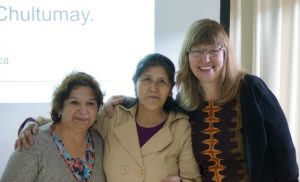
Mapping Adult Education in Saskatchewan: An Arts-Based Performance Project
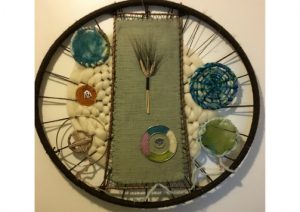
Five doctoral students, Juliet Bushi, Romina Bedogni Drago, Heather Fox Griffith, Pam Klein, and Titilayo Olayele in the Faculty of Education’s Adult Education Program chose to explore the topic of learning pathways to higher education for their group project in their fall 2015 EAHR 931 course with Dr. Cindy Hanson. They entitled their arts-based, participatory performance, “Mapping Adult Education in Saskatchewan: The Stories.”
Their task was to map sites of Adult Education in Saskatchewan, but after developing a comprehensive database and exploring how they might interpret the data, they realized that an important piece of the puzzle was missing: the non-formal learning pathways. To address this lack, they conducted case studies on the individual learning journeys that brought each presenter to the University of Regina, which they shared as part of their arts-based performance, extending their inquiry to include the stories of the students who were invited to attend, and thus, participate in the performance. Read more…
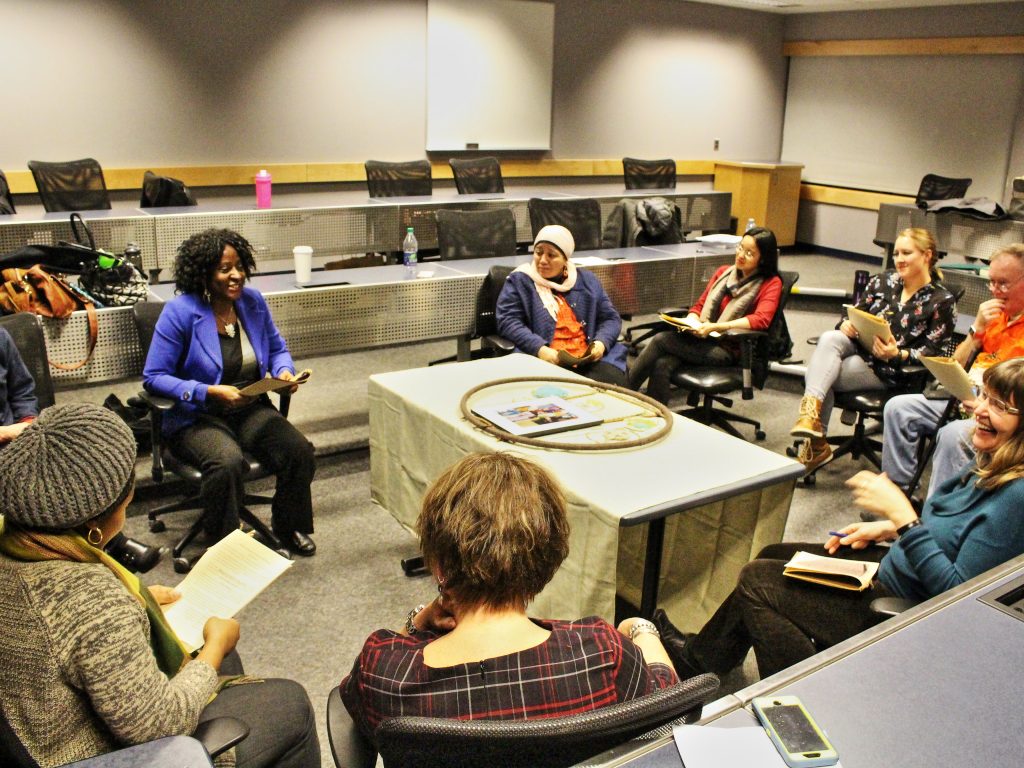
Mapping Adult Education in Saskatchewan: An Arts-Based Performance Project
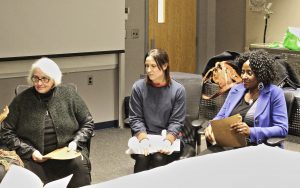
Five doctoral students, Juliet Bushi, Romina Bedogni Drago, Heather Fox Griffith, Pam Klein, and Titilayo Olayele in the Faculty of Education’s Adult Education Program chose to explore the topic of learning pathways to higher education for their group project in their fall 2015 EAHR 931 course with Dr. Cindy Hanson. They entitled their arts-based, participatory performance, “Mapping Adult Education in Saskatchewan: The Stories.”
Their task was to map sites of Adult Education in Saskatchewan, but after developing a comprehensive database and exploring how they might interpret the data, they realized that an important piece of the puzzle was missing: the non-formal learning pathways. To address this lack, they conducted case studies on the individual learning journeys that brought each presenter to the University of Regina, which they shared as part of their arts-based performance, extending their inquiry to include the stories of the students who were invited to attend, and thus, participate in the performance.
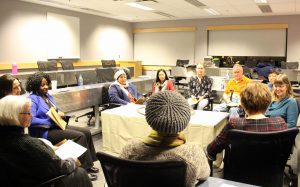
The diversity within the group of presenters and participants enriched the performance with a broad collection of cultural and international learning experiences: For example, one participant was born in Sudan, had spent time in England, Switzerland, and the United Arab Emirates before finally coming to Canada, to the University of Regina (U of R). Another followed in the footsteps of his son, who had come to the U of R from China, and whose experience at the University so piqued his interest, he decided to become a student here as well. Another had gathered the threads of her learning-pathway story as she travelled from Nigeria to Vancouver, BC, to Grande Prairie, AB, and finally to Regina, SK, to study at the U of R. Others who originated from Canada spoke of their international travels as significant informal learning, such as one student whose travel in the Czech Republic had transformed her thinking about her own abilities.
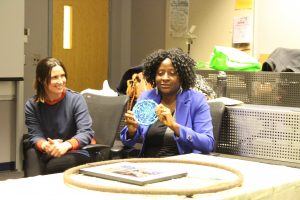
As the presenters shared their learning-pathway stories through poetry and narrative, each presented a hand-made, woven hoop, and explained why they had chosen the colours and design, and then added their smaller hoops to the larger hoop, which represented the circular nature of their shared journeys and their own unique learning pathways. They organized the classroom into a sharing circle to represent the weaving together of the stories of both the performers and participants into the hoop. The final product with the pieces added by presenters was woven into an installation artwork.
The materials for the artwork are 100% natural, with cashmere merino blend wool used for weaving, and sage green burlap for the province-shaped centre. This work of art will be placed in the Faculty of Education for viewing.
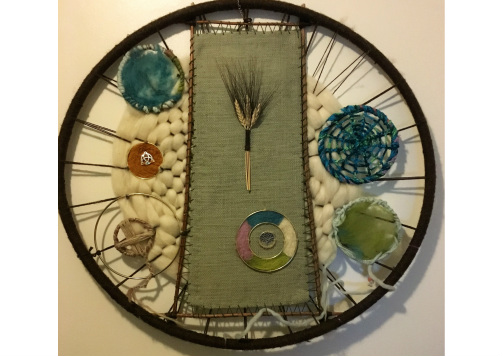
To view the project and read the poetry and narratives of the group, visit www.mappingadulted.ca
The web site also details their research process and methodology and offers a database of adult education opportunities in Saskatchewan.
The Adult Education program, University of Regina has a Facebook public group page: https://www.facebook.com/groups/adulteduregina/
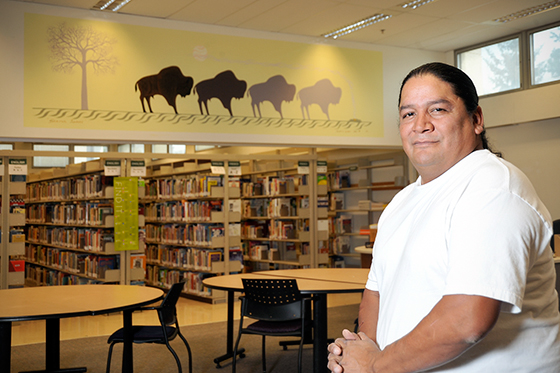
New Mural Brightens Up a Corner of the Campus
Each time Keith Adolph looks out of his office, he sees a work of art that brightens his day.
It’s a new mural that graces a wall at the Teaching Preparation Centre, a library and work space for education students located on the second floor of the education Building.
“It’s great. It draws me in and invites me to look at it longer,” says Adolph who is the Centre’s coordinator. “It feels like I’ve helped make this space a little more organic. It feels more like a learning space and a place for people to be in.”
The mural, called Spiritual Journey, is the work of Cliff Dubois, an artist from the Pasqua First Nation. Central to the theme are four buffalo, walking on sage, shown to signify various stages of life.
“The buffalo that are walking begin in the physical form and slowly fade, eventually making the journey to the spirit world,” says Dubois whose spiritual name is Strong Wind and is indicated by his trademark tiny tornado sketch in the lower right corner of his works. “At the end of the buffalo is a smudge with smouldering smoke that crosses the sky which represents the universe. The smudge offers purification for the soul.”
The mural became a reality thanks to the enthusiastic support of the Faculty of Education and other members of the campus community. The project was funded by the U of R’s Indigenous Advisory Circle.
Dr. Shauneen Pete, Executive Lead on Indigenization, recommended funding for the project.
“For me this project is very much in support of the Strategic Plan. Indigenizing spaces is about changing the physical spaces and by adding the signage and images,” says Dr. Pete. “This is a good way of realigning Indigenous imagery and making them prominent and normal. I can’t wait to see how our students respond to this image and the discussions it will provoke. I’m really happy with it.”
From the beginning, Adolph envisioned a mural with a First Nations theme.
“We’re on Treaty 4 land and with the Indigenization movement we see on campus, I want to be a part of that,” says Adolph. “I want the students coming into this space to feel they’re being represented.”
The mural is located in Room 228 of the Education Building. Adolph encourages you to drop by for a look.
The Faculty of Education prides itself on being one of the best in Canada and offers exciting opportunities. Please visit us here for more information.
Artist Simone McLeod With Her Artwork
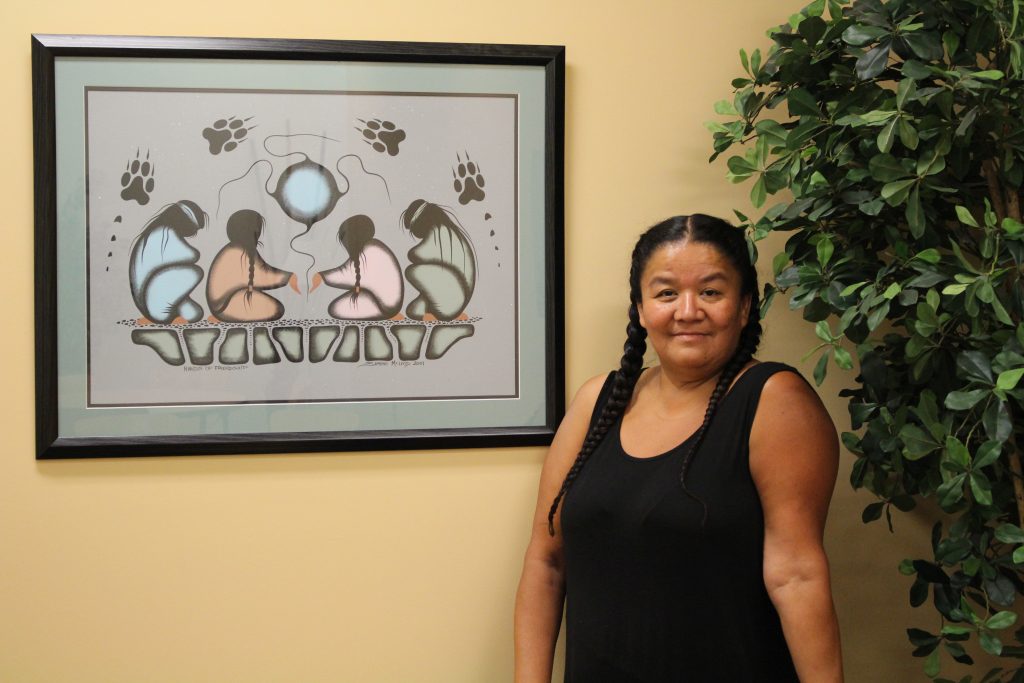
First Nations Woodland artist Simone McLeod was on campus today with her brother Artist Cliff Dubois, who is painting a buffalo mural on our Teaching Preparation Centre wall. One of Simone’s works, “Hands of Friendship,” is hanging in our Faculty Lounge. She was pleased to see it again. She painted this work in 2001 and notes the differences in her artwork from then to now. Her colours were more pastel in this work (now she uses more vibrant colours) and she was using a watercolour paper. Simone has been painting for 20 years. More of her work is exhibited online at http://www.fisherstarcreations.com/simonemcleod-acrylics
